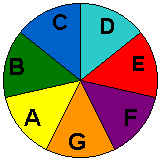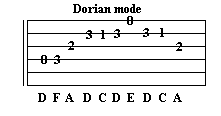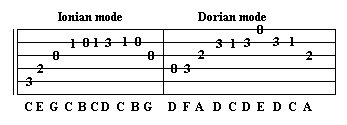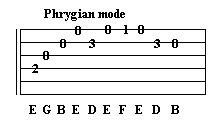What I would like to do is show you a technique for writing great melodies using any key or scale. For our first example, we will use the key of C major. It may be a good idea to read up on the key of C major.
|
|
|
 |
|
The illustration above shows the notes and chords of the key of C major. The upper right box shows the chords and each note of each chord in the key of C major. It would be a good idea for you to memorize each note of each chord in the key of C Major.
 |
|
You really should have studied the modes chapter and I will leave that up to you now. I will now explain how you can build a melody using each of these modes. Usually when you write music you start with a key or tonal center. The song or piece of music is based around the home, or tonic note of that key. For this example, we will use the key of C major. So this means that the C note or chord will be the home or tonic chord.
Everything we write will revolve around and resolve back to this chord. In our first example we will use everyone of the modes in the key of C major. This is an example to get you playing everyone of these modes in the melody. We need to take this system of development one step at a time. Here's an illustration of the notes in the key of C major covering up to the 9th fret or so. You can use this for referencing note placement of the key of C major. You can also use this following table to reference all the notes for each key.
|
|
I would also like to pick 6 additional notes to add to the 4 we picked above. I will pick the B, C, D, C, B and G notes just because I want to. This is how you experiment. The reason why I am picking the notes of the C chord, is to get you playing the notes that make up each chord in the key of C major. But we could have used any of the notes in the key of C major scale we wanted to. Look at the table below and notice the notes in the top row next to the C or Ionian mode. The notes are C, E, G, C, B, C, D, C, B and G. These are the beginning notes of our melody. We will now use these notes to construct our melody for each mode in the key of C major. On your piece of paper write out Ionian. Next to Ionian write out each note as shown below.
Now for the secret to developing the rest of our melody. Your piece of paper should have the notes as shown above, C, E, G, C, B, C, D, C, B and G.
So far we have played the notes created in the Ionian row and the Dorian row. We can put those together now. Look below and see what that would look like.
Look at the table below once more. Once again we took the notes of the C chord C, E, G and C. We then added 6 more notes, any notes we wanted to. We then have the notes that are in the top row below. We then raised each note by one note in the following row. We now continue to increase each note by one note for all the following modes in the key of C major. By doing this we are creating a melody in every mode. Since it is mathematical every mode will begin with the notes of the chord for that particular mode.
If we tab out the Phrygian row we would have the illustration below.
We will now join the Ionian row, the Dorian row and the Phrygian row together.
|
| Ionian | C | E | G | C | B | C | D | C | B | G |
| Dorian | D | F | A | D | C | D | E | D | C | A |
| Phrygian | E | G | B | E | D | E | F | E | D | B |
| Lydian | F | A | C | F | E | F | G | F | E | C |
| Mixolydian | G | B | D | G | F | G | A | G | F | D |
| Aeolian | A | C | E | A | G | A | B | A | G | E |
| Locrian | B | D | F | B | A | B | C | B | A | F |
| Ionian | C | E | G | C | B | C | D | C | B | G |
The next row would be the Lydian row. The Lydian mode is a major mode and in the key of C major would be the F Lydian mode. The notes of the F chord are, F, A and C. Once again by raising the notes by 1 note, we have created the same melody in each row. It may be the same melody, but you will notice the different sound each mode creates. You will also notice some awkward fingerings which is a good thing.
 |
This illustration shows the F Lydian row in tablature. Once again you need to play these notes and understand that you are playing over the F chord and using the F Lydian mode. The Lydian mode is a major mode and the F chord is a Major chord. We can now add this melody to the others. |
 |
You need to play each of these runs now until you have them memorized.
You will notice as you play these notes when you reach the Lydian mode it will want to come to an end when you hit that final C note in the Lydian box. Our first note in the Ionian box was the C note, the last note in the Lydian box is a C note. The melody wants to come to a final. You can read up on cadences in that chapter and see how you can build progressions in each key. But what I would like to do is continue to tabulate each mode for your benefit. The next mode we need to work on is the Mixolydian.
| Ionian | C | E | G | C | B | C | D | C | B | G |
| Dorian | D | F | A | D | C | D | E | D | C | A |
| Phrygian | E | G | B | E | D | E | F | E | D | B |
| Lydian | F | A | C | F | E | F | G | F | E | C |
| Mixolydian | G | B | D | G | F | G | A | G | F | D |
| Aeolian | A | C | E | A | G | A | B | A | G | E |
| Locrian | B | D | F | B | A | B | C | B | A | F |
| Ionian | C | E | G | C | B | C | D | C | B | G |
Look at the Mixolydian row above. Once again the first 4 notes make up the G chord. The G chord is a major chord, so the Mixolydian mode will be a major mode.
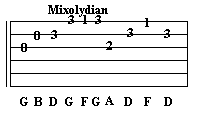 |
Play these notes and understand that your playing the notes of the G chord and using the notes of the Mixolydian mode. |
We can now add this melody to the others we have created. This may seem like a lot of work, but it is well worth your time. You can have some blank tab sheets handy and you can find them here. You can use these blank tab forms to write out your own ideas. You don't have to use as many notes as we did in this first example. You can use 3, 4, 5 or as many notes as you like. We will have more examples, but we need to finish the tablature for this exercise.
 |
|
 |
So far we have constructed the tablature for each of the modes in this illustration. You need to play each of these exercises until you have them down. If you have a recorder, play the chords for each melody. C, Dm, Em, F and G. You can then play each tabbed exercise over the chords. |
Now we need to work on the Aeolian mode. The Aeolian mode is a minor mode and is also relative to the key of C major. The Aeolian mode is a very popular minor mode and you will learn more about that mode throughout our lessons. The Aeolian mode in the key of C major is the A Aeolian mode and represents the A minor chord or A note in the key of C major. The Aeolian mode is the 6th mode in every major key. Look at the notes in the Aeolian row. Once again the first 4 notes are the notes of the Am chord. The notes that make up the Am chord are A, C and E.
| Ionian | C | E | G | C | B | C | D | C | B | G |
| Dorian | D | F | A | D | C | D | E | D | C | A |
| Phrygian | E | G | B | E | D | E | F | E | D | B |
| Lydian | F | A | C | F | E | F | G | F | E | C |
| Mixolydian | G | B | D | G | F | G | A | G | F | D |
| Aeolian | A | C | E | A | G | A | B | A | G | E |
| Locrian | B | D | F | B | A | B | C | B | A | F |
| Ionian | C | E | G | C | B | C | D | C | B | G |
We will now write tablature for the notes in the Aeolian row above.
 |
I've written out this tab using a few different positions. This was done to have you play some different notes in different places. You can even slide to the A note on the 5th fret if you like to. You need to try different things to come up with ideas. If you continue to practice the same things over and over, it's hard to grow and expand your knowledge. We can now add this part to the others we have constructed. |
 |
|
 |
We can now play all of these together and begin to really develop playing over different chords. We only have one more melody to write out. |
The final melody will be the B Locrian mode. This is a Diminished mode and can really sound neat. Normally you may over look this mode, but by constructing melodies the way we have, makes playing and developing odd scales very easy to do.
| Ionian | C | E | G | C | B | C | D | C | B | G |
| Dorian | D | F | A | D | C | D | E | D | C | A |
| Phrygian | E | G | B | E | D | E | F | E | D | B |
| Lydian | F | A | C | F | E | F | G | F | E | C |
| Mixolydian | G | B | D | G | F | G | A | G | F | D |
| Aeolian | A | C | E | A | G | A | B | A | G | E |
| Locrian | B | D | F | B | A | B | C | B | A | F |
| Ionian | C | E | G | C | B | C | D | C | B | G |
We now have to construct the tablature for the B Locrian scale. I would like to write out the tab starting on the B note 2nd fret A string and not on the open B string. This way we can play this scale in just the 1 position. Check out the tablature for this and you will see what I mean.
 |
Here is the tablature for the Locrian mode. This mode sounds really neat, you are playing the notes of the B diminished chord. The Locrian mode is a diminished mode and is always the 7th mode in the major key. We can now add this to the others we've constructed. |
 |
 |
We have now constructed every melody covering every mode in the key of C major. All we had to do was pick some notes out of the scale we wanted to use and then increase each note to the next note. By doing this we've created a different melody for each scale or mode in that key. We then wrote the tablature for each row of notes we decided to use. By doing this we were able to play a different melody in every mode in the key of C major. This idea will work with any scale you would like to use. You could use the melodic or harmonic minor scale. There are no boundaries. You don't have to use the notes of each chord if you don't want to.
| Ionian | C | E | G | C | B | C | D | C | B | G |
| Dorian | D | F | A | D | C | D | E | D | C | A |
| Phrygian | E | G | B | E | D | E | F | E | D | B |
| Lydian | F | A | C | F | E | F | G | F | E | C |
| Mixolydian | G | B | D | G | F | G | A | G | F | D |
| Aeolian | A | C | E | A | G | A | B | A | G | E |
| Locrian | B | D | F | B | A | B | C | B | A | F |
| Ionian | C | E | G | C | B | C | D | C | B | G |
I would like to give you another example of how this can work for you.
I would like to give you a real basic idea on how this system of melody
creation works. To start things off, we will just use the notes of the C
chord. This way you will get the technique down to create melodies of your
own.
|
Once again the notes we are going to use will be out of the key of C major. They are as follows:
C, D, E, F, G, A, B and C. However in this example we are only using the notes of the C chord. The notes in the C chord are, C, E and G. We will use the low C and the C one octave away in this example. We then write out those 4 notes. They are the notes below in the top row. Find those notes C, E, G and C. Now we raise each note below the notes that we picked. By doing this, we have created the notes of every chord in the key of C major. Notice the Dorian row. It has the notes D, F and A. These are the notes of the Dm chord.
The Phrygian row has the notes, E, G and B. These are the notes of the Em chord. You can tab out these notes and can play these all over the fret board.
| Ionian | C | E | G | C |
| Dorian | D | F | A | D |
| Phrygian | E | G | B | E |
| Lydian | F | A | C | F |
| Mixolydian | G | B | D | G |
| Aeolian | A | C | E | A |
| Locrian | B | D | F | B |
In the following example I would like to use the key of G major. The key of G major has the notes that follow: G, A, B, C, D, E, F# and G. Notice that we wrote out the key of G major in the top row. This will construct the key of G major or also called the Ionian mode. We then raised each note by 1 in the rows under the first. This is an easy way to put all of the modes and their notes in the proper order. If we wanted to write a melody using the notes in the key of G major we would start with the G note.
| Ionian | G | A | B | C | D | E | F# | G |
| Dorian | A | B | C | D | E | F# | G | A |
| Phrygian | B | C | D | E | F# | G | A | B |
| Lydian | C | D | E | F# | G | A | B | C |
| Mixolydian | D | E | F# | G | A | B | C | D |
| Aeolian | E | F# | G | A | B | C | D | E |
| Locrian | F# | G | A | B | C | D | E | F# |
| Ionian | G | A | B | C | D | E | F# | G |
You can pick any of the notes you would like to use. I will pick a bunch of notes starting with the G note.
| Ionian | G | D | C | B | C | B | A | G | C | B | A | G | A | |
| Dorian | A | E | D | C | D | C | B | A | D | C | B | A | B |
Here's a cool one you should really practice. Just take two notes and play them from the G note 15th fret high E string to the G note 15th fret Low E string. Take the notes G and E write out all the notes in the descending direction. This will be the opposite way of adding the notes this time. Playing from high to low direction. You should play this in every key and starting on every note along the high E string.
|
 |
||||||||||||||||||||||||||
| The tablature is written out above for the notes to the left. I would recommend that you learn how to play this up and down the guitar fret board. This is a great exercise and can also be an effective solo. All I did was take two notes out of the key of G major and lowered each note in order under the two notes we used. When you make up your ideas, you can do them in any order and any notes you want to. If they sound a bit funny, you can change a note or two. Let your ear decide whether it sounds funny or not. By making up different ideas using this system, you will begin to play things you never thought of. Pick a few notes out of the scale you would like to use and use the system we've covered. Put them in tablature form and begin to work with them. |
Another good idea would be to use this technique with the progressions you will be playing. For example say you are working with the progression, Am, G and F. Take each chord of the progression you are working with and use the melody technique to come up with melodies over each of the chords. For this example I have used the Am scale. A, B, C, D, E, F and G. I will use the progression Am G and F. I picked 5 notes out of the Am scale starting with the A note, these notes are in the top row next to the Am chord.
I then descended the notes in order for each chord in the progression. When you play this lead, you play descending or from the A note 5th fret high string to the D note 7th fret G string.
| Am chord | A | G | F | E | F | |
| G chord | G | F | E | D | E | |
| F chord | F | E | D | C | D | |
Now I would like to show you how to figure out all the 7th chords for each chord in any scale. The first thing we do is write out the scale we are going to use. For this example I will use the Am scale. The Am scale is relative to the key of C major. Check out this table and all the gray boxes represent the relative minor to the key it is in.
Here are the notes of the Am scale. A, B, C, D, E, F, G, A
All chords are built upward in thirds and each note above can be given a
number. Each note in the Am scale has been given a number in the table below.
Since all chords are built upward in 3rds the Am chord would have the notes, A,
C and E. If you wanted to construct the Am 7 chord you would add the 7th note.
The seventh note would be the G note. So the Am chord would have the notes A, C,
E and G.
| 1 | 2 | 3 | 4 | 5 | 6 | 7 |
| A | B | C | D | E | F | G |
So we can construct any chord we like by using the system we have been working on. We need to make a table and start with the notes of the Am 7 chord.
| Am 7 | A | C | E | G |
|
B dim 7 |
B | D | F | A |
| C major 7 | C | E | G | B |
| Dm7 | D | F | A | C |
| Em7 | E | G | B | D |
| F major7 | F | A | C | E |
| G 7 | G | B | D | F |
Look at the chords above that are now 7 chords. If you would like to play lead over the minor chords a good trick is to use the scale of the notes in the yellow box. You can use the G major scale to play over the Am7 chord. The Am mode in G major would be the Dorian mode.
You can use this system to do anything you can come up with. Tab out each of these chords above and learn the fingering for each of them all over the fret board. Before you know it, you will be playing all of these in your lead work. If you ever have any questions on this technique, please drop me a line.
I wish you the best of luck,
From the jam Room

